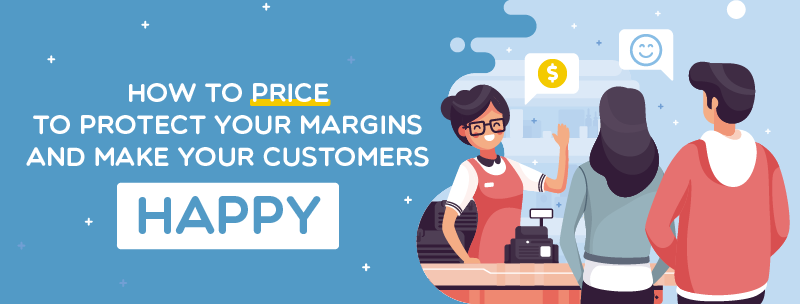How to Price to Protect your Margins and Make your Customers Happy
03-17-2025

The price set on a product has a significant impact on both customers’ consuming behavior and shop owners’ profit. Overpricing a product will grind purchases to halt, while under charging it will not guarantee retailers’ average level of profit margins. There must be a pricing strategy offering an optimal price level for retailers to cover all the costs and maximize the profit while holding an appeal to buyers.
What is product pricing?
Product pricing is a process of determining the value that firms might get by exchanging goods and services in the market. It is also considered a part of an organization’s marketing strategy in order to earn more revenue. On the other hand, product pricing has a direct influence on a company’s failure or success.
According to microeconomic theory, the profit maximizes when prices are set in when the marginal cost is equal to marginal revenue. However, many researches have pointed out that the concept of marginality rules is not applicable in every case. In reality, firms tend to follow the pricing approaches based on different market circumstances. Every price set on a particular product is to accomplish certain business objectives.
The art of pricing: Holiday shopping special edition
Price is the most considered factor during seasonal shopping holidays when the competitive market holds a wide range of choices offered by dozens of different online stores. Prices in this period often experience a wild fluctuation due to the constantly changing demands of customers. For the reason, store owners ought to be clever with pricing techniques that can satisfy buyers. Here are some suggestions.
Price guarantee
When a customer is demanding a product but hesitating to make a purchase, he or she may not be facing a financial shortage but an implicit fear of witnessing the same product at a much lower price level. The method of price guarantee might be the most lucid decision to prevent this occurrence. Price guarantee (also known as price - matching guarantee) is an arrangement in which suppliers promise to refund the difference (or a proportion of the price) if customers find a better deal in the market.
Here is an example of a price guarantee made by UK Direct Office.co:
“Low Price Guarantee

We pride ourselves on offering our business customers the very best prices… guaranteed!
In the unusual case that another online retailer is publicly offering the same individual product at a lower price and sold with the same sale conditions, we not only match the price, but we’ll also refund you an additional 10% of the difference.
Our low price guarantee is subject to the terms and conditions set out below”.
Guarantee in price is basically a psychological approach aiming to give customers a sense of security and comfort to make a large quantity of order while in fact, customers will still have to pay more for the arising costs that later discussed in the detailed contact with retailers.
Promotions
The spending spree in holiday shopping seasons mainly results from attractive promotion offers where discounts are the key feature to target customers. The statistics from NFR ’s annual holiday survey indicate that three over four customers reported that promotions play an integral role in their shopping experience, and the majority of shoppers admitted that a third of their purchase decisions depended on whether the price was on discount. In fact, customers’ demands would drop significantly when the desired products were not on sale.

Discounts fulfill customers’ greed and help gain potential customers, which is a positive sign for retailers, but doing business is not just about satisfying your customers but also earning profit.
In order to guarantee margins, other than offering some common types of discounts such as dollar or percentage off, buy one get one (BOGO),. business owners should apply the formula for quantity discount in which shoppers reach a certain threshold to receive a discount. For example: “20% off when you spend 250$”, “Purchase 3 items and get the 4th one for free”, etc. It appears both as an incentive to buyers and an opportunity for sellers to supply more goods and increase revenues.
Price intelligence
Price intelligence provides the function of tracking, monitoring and analyzing data of how other market competitors price in order to adjust your pricing decisions. Product pricing generally witnesses rapid changes in holiday seasons, therefore, it is a must for retailers to supervise their pricing level perpetually to keep track with their customers’ consumption.
There are 3 main steps for retailers to follow in order to utilize price intelligence for a better business growth, according to Total Retail :
Step 1: Use automation
The data collection in price monitoring must be scalable. The large number of both existing and increasing data arises a demand a procedure to efficiently keep track of those statistics. This is where automation gets in to replace the outdated manual techniques which were time-consuming and inefficient. Data collection, with the support of automation function, can now be guaranteed with accuracy and resources saving.
Recent-day price monitoring is defined as the act of using algorithms to gather information of similar products in which the titles and images do not match. Applying automation, in this case, technically helps to collect information about competitors’ pricing level more precisely. Use a best price monitoring software to help you understand your market.
Step 2: Generate an effective pricing strategy
First of all, know your “enemies”. Try your best to detect the competitors selling the same products or products of the same category to compare prices for later adjustment. It is also a strategy to evaluate your position in the market.
Secondly, rewind pricing development. Conduct researches in the past pricing trends to conclude the overall reasons for the success or stagnation of pricing behaviors. The ultimate aim is to win over competitors with a thorough understanding of the market trends.
Lastly, prepare to analyze the data with high-tech programs and software that provide clean and creative visualization of the given data.
Step 3: Make an immediate movement
Pricing data tend to get behind times in seconds. The collected and analyzed data from using price intelligence should be immediately applied to maximize the efficiency of the strategy or else they would become unconnected. Outdated data may consequently result in the product’s obsolescence, for example, the data of the price for ski jacket collected in December, but not reviewed until May will not give any help in promoting the product.
Price testing
The idea of price testing is exactly what it sounds like: retailers test their pricing decisions by letting the customers select the right price other than using optimization tools.
Ways to conduct a price test
It is important for firms to be comprehensible of the data they are following. Plan some projects to get the most of each price test. The following strategies are the most common ways to test the price:
- Offer discounts, promotions or gift certificates to see the influence of lower price on customers.
- Set different prices for the same product at different periods of time to see the customers’ reaction to each price level. Offer different editions of the product at different prices to see the impact on purchasing level
Why price test
Price testing system is a useful application to precisely measure price elasticity which is an important factor contributing to decide the price point where margin profit maximizes.
Business owners can hold the advantage of pricing power in the market in 2 ways: “You can either beat them on price or you can beat them on value’’ said AG Lafley, CEO of Procter & Gamble.
What Lafley referred to is that firms can either offer appealing promotions, discounts and services which lower the price to attract customers, or build a credible brand that can provide value at an optimal level where price is not a big deal. These are areas where consumers are willing to pay for price premiums, in which companies can maximize margins. Some firms may be unwilling to apply these price testing systems for fear of the negative responses from customers, but making pricing decisions without understanding what customers demand will not guarantee a positive outcome.





